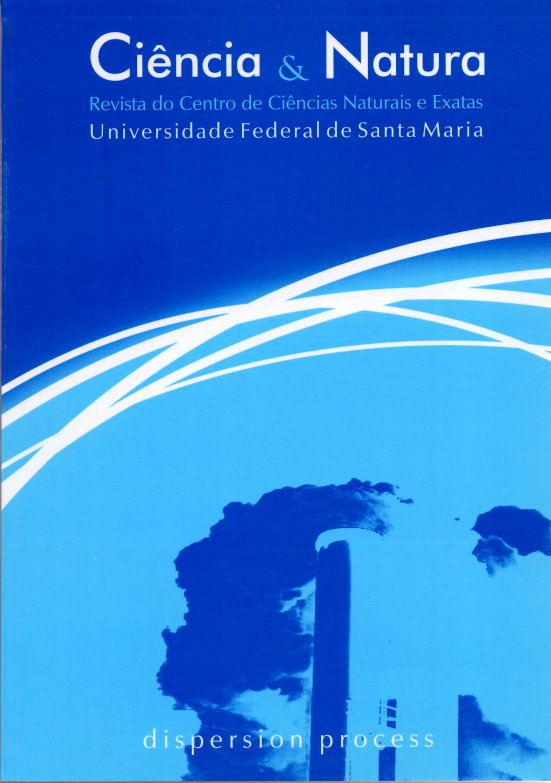A method for accurate measurement of chemical elements concentrations present in total suspended particulates and PM 10 in the atmosphere
DOI:
https://doi.org/10.5902/2179460X63627Abstract
In this paper we present an analytic method for theidentification and the quantification of chemical elements in theatmosphere present in TSP and PM10. To the present moment, themethod is applicable to a total of 16 metals. The method was used toanalyze TSP and PM10 samples collected in the city of Canoas, in thegreater Porto Alegre, Brazil. In order to obtain relative measures ofPM10 concentrations, the method was also used to analyze samples from a neutral location. The results were checked against electronicmicroscopy findings, having an excellent agreement. Geologicalanalysis of the electronic microscopy results was used to infer thepollutants source.
Downloads
References
BOUBEL, R.W; FOX, D.L.; TURNER, D.B.; and STERN, A.C., (1994), Fundamentals of air pollution - 3.ed. - Ed. Academic Press, Califórnia. DOI: https://doi.org/10.1016/B978-0-08-050707-1.50005-6
BRUNEKREEF, B.; JANSSEN, N. A . H.; de HARTOG, J.; HARSSEMA, H.;KNAPE, M. and van VLIET, P. (1997), Air Pollution from Traffic and Lung Function in Children Living Near Motorways. Epidemiology 8, 298- 303. DOI: https://doi.org/10.1097/00001648-199705000-00012
CHAN, L. Y.; KWOK , W. S. ( 2001), Roadside Suspended Particulates at Heavily Trafficked Urban Sites of Hong Kong-Seasonal Variation and Dependence on Meteorological Conditions, Atmospheric Environmental 35, 3177- 3182. DOI: https://doi.org/10.1016/S1352-2310(00)00504-5
DONALDSON, K. (1999) , The role of Ultrafine Particles in the Toxic Effects of PM, Guest article, Biomedicine Research Group. Napier University, 10 Colinton Rd, Edinburgh.
EPA (1997, July 17), Health and Environmental Effects of Particulate Matter, Office of Air and Radiation, Office of Air Quality Planning and Standards, U.S. Environmental Protection Agency, Research Triangle Park.
EPA (1998), Handbook for Air Toxic Emission Inventory Development, Volume I. EPA-454/R-98-002.
EPA (2000), National Emission Inventory Data , Incorporation Plan .
EPA (1993), Introduction to Air Pollutant Emission: Estimation Techniques for Industry.
JANSSEN, N. A . H.; HOEK, G; HARSSEMA, H. and BRUNEKREEF, B. (1997b), Childhood Exposure to PM10: Relationship Between Personal, Classroom and Outdoor Concentrations. Occupational and Environmental medicine 54, 888-894. DOI: https://doi.org/10.1136/oem.54.12.888
MARCAZZAN, G. M.; VACCARO, S.; VALLI, G. and VECCHI, R., (2001), Characterization of PM10 and PM2,5 Particulate Matter in the Ambient Air of Milan ( Italy), Atmospheric Environment, 35, 4639-4650. DOI: https://doi.org/10.1016/S1352-2310(01)00124-8
PFEFFER, H. U. (1994), Ambient Air Concentrations of Pollutants at Traffic- Related Sites in Urban Areas of North – Rhine-Westphalia, Germany. Science of the Total Environmental 146/147, 263-273. DOI: https://doi.org/10.1016/0048-9697(94)90245-3
PONKA,A. (1998), Mortality and Air pollution in Helsinki, Environmental Health 25.
PROCHNOW, E. A .; PROCHNOW, T. R.; TORRES, E. Mac M.; LIBERMAN, B; OCÁCIA, G. C.; SOLIMAN, E.; BIANCHI, A .; COIMBRA, M. A .(2000), Análise de Partículas em Suspensão na Região Metropolitana da Grande Porto Alegre: Técnicas Analíticas para Identificação de Metais em Poeira, Anais da 52ª reunião Anual da SBPC, Brasília.
Downloads
Published
How to Cite
Issue
Section
License
To access the DECLARATION AND TRANSFER OF COPYRIGHT AUTHOR’S DECLARATION AND COPYRIGHT LICENSE click here.
Ethical Guidelines for Journal Publication
The Ciência e Natura journal is committed to ensuring ethics in publication and quality of articles.
Conformance to standards of ethical behavior is therefore expected of all parties involved: Authors, Editors, Reviewers, and the Publisher.
In particular,
Authors: Authors should present an objective discussion of the significance of research work as well as sufficient detail and references to permit others to replicate the experiments. Fraudulent or knowingly inaccurate statements constitute unethical behavior and are unacceptable. Review Articles should also be objective, comprehensive, and accurate accounts of the state of the art. The Authors should ensure that their work is entirely original works, and if the work and/or words of others have been used, this has been appropriately acknowledged. Plagiarism in all its forms constitutes unethical publishing behavior and is unacceptable. Submitting the same manuscript to more than one journal concurrently constitutes unethical publishing behavior and is unacceptable. Authors should not submit articles describing essentially the same research to more than one journal. The corresponding Author should ensure that there is a full consensus of all Co-authors in approving the final version of the paper and its submission for publication.
Editors: Editors should evaluate manuscripts exclusively on the basis of their academic merit. An Editor must not use unpublished information in the editor's own research without the express written consent of the Author. Editors should take reasonable responsive measures when ethical complaints have been presented concerning a submitted manuscript or published paper.
Reviewers: Any manuscripts received for review must be treated as confidential documents. Privileged information or ideas obtained through peer review must be kept confidential and not used for personal advantage. Reviewers should be conducted objectively, and observations should be formulated clearly with supporting arguments, so that Authors can use them for improving the paper. Any selected Reviewer who feels unqualified to review the research reported in a manuscript or knows that its prompt review will be impossible should notify the Editor and excuse himself from the review process. Reviewers should not consider manuscripts in which they have conflicts of interest resulting from competitive, collaborative, or other relationships or connections with any of the authors, companies, or institutions connected to the papers.







